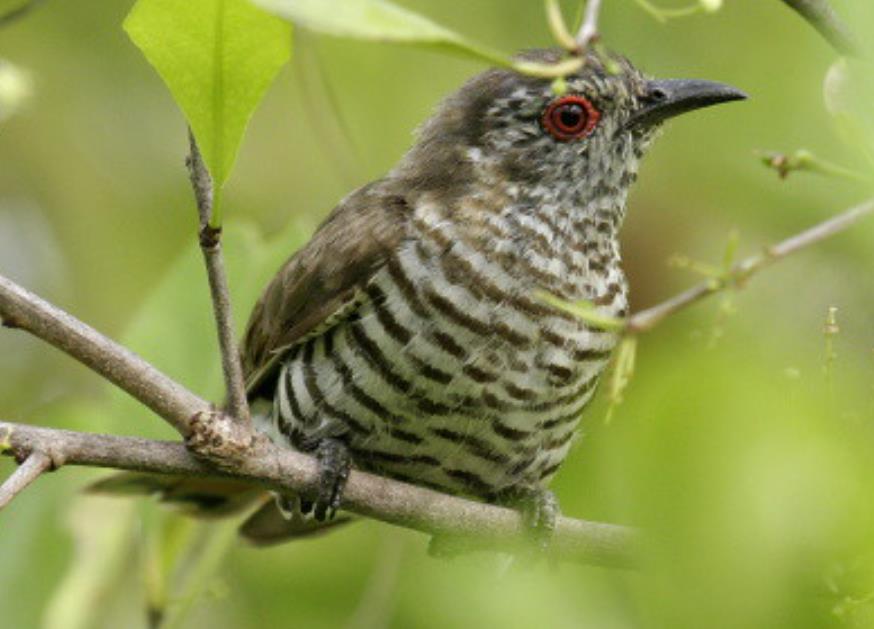Family: The little bronze cuckoo (Chrysococcyx minutillus) is a member of the cuckoo family Cuculidae in the genus Chrysococcyx.
Habitat and Behavior: The little bronze cuckoo has the parasitic habits of most other Australian cuckoos. Like other bronze cuckoos, the Little is rather solitary and quiet, a graceful flier, and, living in the mid-stages of rainforest and broadleaf scrub, feeds on insects and caterpillars by perch-and-pounce sallying. Congregations of three to six courting birds are rare and brief during breeding.
In the north, it usually lays its eggs in the nest of the large-billed gerygone, and on the central east coast, in those of the white-throated gerygone, although at least another eight species serve as foster parents to its young. The egg of the cuckoo often hatches before the eggs of the host, and the young cuckoo ejects the host’s eggs from the nest, manipulating them up to the edge by cupping the egg in the hollow of its back and gripping the wall of the nest with its strong claws. If the host’s chicks have already hatched, it ejects them in much the same manner.
Gerygones often construct dome-shaped nests, with an overhang covering the opening. Since there is no imitation and the interior is dark, it may be easier for the cuckoo to conceal its brightly colored egg from the host. There is, nevertheless, a striking similarity between the nestlings of the versatile Little Bronze Cuckoo and those of its hosts. Nestlings parasitizing large-billed Gerygones are black-skinned with four white tufts on the back of the crown, hardly different from those of their host’s except for lacking additional wisps on the hind crown and white down on the back.
The northwestern race of the Little Bronze-Cuckoo (Chrysococcyx malayanus minutillus) intergrades with the rufous-breasted race c.m. russatus in northern and northeastern Queensland, south of Bowen-Mackay. Both of these populations are sedentary, but the darker, more pronouncedly marked southernmost race, c.m. Barnardi, migrates northwards from the central east coast during the winter to New Guinea and Cape York, becoming interspersed with the rufous-breasted form in a confusing array of plumages.
Identification: The male crown and back of the head are dark bronze-green; the mantle, shoulders, back, and rump are light to mid-bronze-brown to green, usually contrasting with the head. The side of the face is white, speckled black, with ear coverts forming a small dark spot behind the eye. Flight feathers are mid-brown with a slight bronze tinge to the outer webs and a broad concealed light cream-russet bar through the underwing, showing in flight. The upper surface of the central two tail feathers is back, the remainder becoming increasingly barred black and white towards the outer.
The underparts are white with numerous narrow, dark bronze-green bars. In the northeastern Queensland race, there is a variable russet tinge to the upper surface and inner webs of flight feathers; underparts are cream to white, washed variously rufous on the throat, breast, and bars; and tail feathers are rufous on the inner and outer webs. Eyes are pinkish-red to scarlet; eye rings are orange-red to scarlet. slate to black, with a greenish to grey base of the lower mandible. Feet and claws slate.
The female bird eyering is pale cream-green to cream, and the eye is orange-brown to grey-brown. The immature upper parts are dull bronze brown. The face, lores, and line over the eye are pale grey. The tail is similar to adults but much paler; the neck and throat are greyish or washed russet, the belly and abdomen white, bars becoming more evident with age. Eyes are grey to grey-brown; the eye ring is not pronounced. The bill is grey-brown to slate with a paler base to the lower mandible. Feet are dull slate-grey.
Vocalization: The male advertising calls are a long, high-pitched, rippling sound that sounds like a deep breath, followed by a slow exhale, which results in the trilling sound. This is known as the small bronze cuckoo call. It may be repeated in quick succession, similar to that of a grasshopper. Also, soft piping calls and four-note calls.
Nesting: The nesting and breeding occur in September and January. Parasitic; main hosts: large-billed and white-throated Gerygones and their relatives. Those in the nests of the White-throated Gerygone, by contrast, are pinkish and adorned with yellow plumules, again like the nestlings of the host.
Eggs and Incubation: The bird lays one egg, slightly lustrous, brown to buff-olive, peppered all over but particularly at the larger end with tiny darker specks; long-oval, about 19 x 13 mm.
Distribution: The Little Bronze Cuckoo is found in mangroves, monsoon and rainforests, wattle thickets, stringybark forests, Melaleuca woodland, and gardens across northern coastal Australia and south along the east coast to about Clarence-Macleay Rivers; migrating north in winter, some individuals reaching New Guinea.
Other Names: The bird is also known as Gould’s Bronze-Cuckoo and Rufous-breasted Bronze-Cuckoo.
Size: The Little Bronze Cuckoo measures about 140–160 mm in length.
Races: There are perhaps 10 to 12 races, but only three are found in Australia.
Read More: Western Gerygone: Nature’s Captivating Symphony









